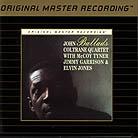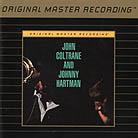February 1999
At the start of St. John’s deepest, most physical and most spiritual musical voyages, his embouchure broke down. For a man who not only played as if his life depended on it, but also practiced ten or so hours a day the same way, this was a crushing blow. Taking part of mid-1962 off to recoup, Ballads and John Coltrane and Johnny Hartman were his first ventures back into the studio after the layoff. Still battling the embouchure, ‘Trane approached these sessions knowing that the pure power he had used to generate his "sheets of sound" was unavailable. What came out of his horn in these recordings instead was a much deeper sound than had characterized his previous playing. Working with a finesse that had only been shown in flashes, Coltrane caresses the melody on both discs, comps behind Johnny Hartman, and adds a direct melancholy sound to his suddenly broadened palette. The result is music that hearkens back to an earlier age of jazz. Unlike later ‘Trane, this is not music to violently force satori. No, this is romantic, moving and gentle music, music to make love by. In fact, I suggest that if you don’t pitch serious woo to Ballads and don’t make love with John Coltrane and Johnny Hartman playing in the background, you have missed out on one of the defining reasons to own audio equipment. Ballads is in many ways the more revelatory of these two discs, simply because on the Hartman sides much of the attention (and rightly so) is focused on the singer. Ballads gives us the gentle side of the quartet that less than two years later would give us A Love Supreme. The warm tone of ‘Trane’s tenor is a joy to hear, as is the smooth piano of McCoy Tyner, but for me the highlight is the joint timekeeping of Jimmy Garrison and Elvin Jones. Jones still gives us a goose, the occasional smack of power, but with the velvet glove firmly in place. And Garrison plays with such effacing beauty that only repeated listenings will show the wonder of it all. On the second disc, Johnny Hartman proves to be the perfect vocalist for this new Coltrane. With a voice that could calm the wildest of storms yet enflame the coldest of hearts, Hartman sings with pure masculine warmth and desire. Learn to lip-sync "You Are Too Beautiful" and you can resolve any marital dispute. There are many versions of "Lush Life," but this one and Nancy Wilson’s are two of the very best ever. And once again, the band plays with a gentle, powerful richness. Perfect for the tone and mood of the lyrics, this is a match of singer and band that happens only on rare occasions. But back to the main reason for a MoFi reissue, the sound. First, these are far better-sounding than the original late-‘80’s Impulse! versions, which comes as no surprise since Impulse! themselves reissued the ‘Trane catalog in 20-bit versions in the mid-’90s. And, of course, Impulse! just released The Classic Quartet – Complete Impulse! Studio Recordings [Impulse! IMPD8-280], which contains the Ballads sessions but not the Hartman tracks. Comparing the MoFi Ballads to the same tracks on the Classic Quartet set shows the MoFi to have greater clarity, a smoother top end, and better staging than the Impulse! set. The differences are not huge, but are significant. Taken as a whole, they add a welcome degree of relaxation, clarity and smoothness to a set of tunes that was only moderately well recorded to begin with and can sound a bit thin and slightly hot on the Impulse! set. The 20-bit Impulse! Hartman set [Impulse! GRD-157] sounds very good, with nice staging, better-than-average clarity and good dynamics. But once again the MoFi edges it. While there is a slight increase in clarity over the Impulse! version, as well as better dynamics, the real strength of the MoFi is in the density of image and the smoothness with which harmonic information is retrieved. Johnny Hartman’s voice is richer without any loss of detail. The piano has greater density and thus is a more natural recreation. Staging is easier to see, and depth is simultaneously expanded and more detailed. Keep in mind that the Impulse! Hartman is a very good transfer and to better it is no mean feat. But that is exactly what the MoFi disc does. So if you don’t have either of these albums, you need to get them both, and MoFi has the best-sounding versions. Because Ballads is part of the highly recommended Classic Quartet set, getting this music in that box may be enough, although the MoFi reissue is a better transfer. But the Hartman disc is absolutely a no-brainer. Get it now, and get the MoFi version. It has simply superior sound. GO BACK TO: |
 John Coltrane Quartet - Ballads
John Coltrane Quartet - Ballads
 John Coltrane and Johnny Hartman
John Coltrane and Johnny Hartman![[Reviewed on CD]](../format/goldcd.gif) Reviewing
reissues is in many ways the easiest of all reviewing tasks. With albums such as these,
the long-term assessment is a given. This music has been played for over 30 years, and
chances are, even if you don’t have the albums, you’ve heard each cut many
times. But because these two albums are a departure from the standard Coltrane, let’s
go over them a bit.
Reviewing
reissues is in many ways the easiest of all reviewing tasks. With albums such as these,
the long-term assessment is a given. This music has been played for over 30 years, and
chances are, even if you don’t have the albums, you’ve heard each cut many
times. But because these two albums are a departure from the standard Coltrane, let’s
go over them a bit.